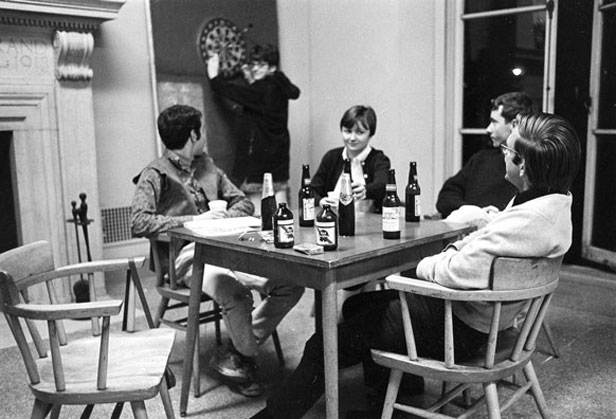A Physicist Walks into a Bar …

On a campus dominated by cold concrete and hard science, the Muddy Charles pub exudes warmth.
On the ground floor of Walker Memorial, the pub welcomes Nobel laureates and graduate students alike. High ceilings and tall windows make the rather small room seem spacious. The fireplace dominating the east wall crackles during cool months; on a balmy August afternoon, the drama of the Little League World Series plays out on a television in a corner, while the windows offer glimpses of Tech Dinghies on the Charles. The Muddy feels like home.
But these days “muddy” describes the future of this pub as much as the river from which it takes its name. With a plan to repurpose Walker Memorial for the Department of Music and Theater Arts under consideration, the Institute has yet to decide where the pub would go during renovations—and whether it would be able to move back afterward.
Begun as a Friday afternoon club, the pub became an official MIT institution (and got its current name) when the Graduate Student Council began running it in 1968. Roughly equidistant from many major departments at MIT, the Muddy pulls together people from across campus, says Joe Contrada ‘76, a high-school chemistry teacher who managed the pub from 1983 to 2004. “This room is all about inclusivity,” he says. “The Muddy belongs here.” If it’s moved permanently, he says, it will wither and die.
Many of the pub’s regulars share this worry. Kenneth Russell, professor emeritus of metallurgy and nuclear engineering, does not mince words: “If the Muddy dies, an important part of MIT life will die.” So a group of supporters have launched the website savethemuddy.com.
Scientists like to unwind at the end of a long day as much as anyone else. And at the Muddy, you’re as likely to overhear a conversation about particle physics as a soliloquy on the prospects of the Red Sox. The combination of cheap drinks and big ideas draws a smart, eclectic crowd and prompted Media Lab lecturer Joost Bonsen ‘90, SM ‘06, to hold his informal venture capital meet-and-greets there. (Bonsen was among the “venture catalysts” in Venture Café, a book about high-tech entrepreneurs that puts the Muddy on its list of places where great ideas can meet great funding.)
Bonsen points to MIT’s Energy Club as an example of a big idea hatched at the pub. Now one of MIT’s largest clubs, it was originally “a small group of students who gathered over beer at the Muddy once a week to talk about various energy topics,” says former president Lara Pierpoint, SM ‘08, PhD ‘11, a postdoc with the MIT Energy Initiative.
But even when conversations at the Muddy don’t focus on science, the pub still serves an important function on campus, regulars say. Russell, who has frequented the Muddy since its early years, says that in all that time, “the spirit hasn’t changed—it’s one of the few human faces of MIT.” He has plenty of memories, including some about the era when Icelandic waitresses staffed the Muddy; they were “very good for business,” he says, but left the place “full of lovesick American males who would just sit there like sick cows.”
He also recalls a bit of Muddy lore about John E. Sununu ‘86, SM ‘87, who would go on to serve as a U.S. senator from New Hampshire. As the story goes, Sununu was once kicked out of the pub. In fact, a friend was asked to leave, and Sununu joined him in solidarity. “My friend was shorter than most of the people there,” Sununu recalls, “and he felt he needed to get up on a table to make a point.” (The point, incidentally, had to do with pi, he says.) Still, Sununu remembers the pub fondly. “There are very few [places at MIT] with the history of the Muddy,” he says.
Sununu isn’t the Muddy’s only friend in high places. Last January, Frans van Vught, policy advisor to the president of the European Commission and former president of the University of Twente, the Netherlands, wrote to Susan Hockfield lauding the pub as “a crucial aspect of the MIT experience.”
As of November, plans to renovate Walker were still up in the air, leaving the Muddy’s fate uncertain. Yet one thing is clear: athletes, teachers, and scholars all feel welcome there, and the people who find their way inside seem to end up with a lifelong affection for the place. No matter your title, says Contrada, at the Muddy “you can make money, make fun, and make friends.”
Keep Reading
Most Popular
Large language models can do jaw-dropping things. But nobody knows exactly why.
And that's a problem. Figuring it out is one of the biggest scientific puzzles of our time and a crucial step towards controlling more powerful future models.
The problem with plug-in hybrids? Their drivers.
Plug-in hybrids are often sold as a transition to EVs, but new data from Europe shows we’re still underestimating the emissions they produce.
How scientists traced a mysterious covid case back to six toilets
When wastewater surveillance turns into a hunt for a single infected individual, the ethics get tricky.
Google DeepMind’s new generative model makes Super Mario–like games from scratch
Genie learns how to control games by watching hours and hours of video. It could help train next-gen robots too.
Stay connected
Get the latest updates from
MIT Technology Review
Discover special offers, top stories, upcoming events, and more.